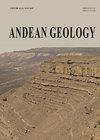Tectonic setting of Cretaceous porphyry copper deposits of northern Chile (28°-30° S) and its relations with magmatic evolution and metallogeny
IF 1.2
4区 地球科学
Q3 GEOLOGY
引用次数: 3
Abstract
Cretaceous porphyry copper deposits of northern Chile (28º-29º30’ S) are genetically related with dacitic to dioritic porphyries and they represent a still poorly-explored target for Cu resources. The porphyries correspond to stocks distributed into two separated discontinuous NS trending belts of different age. The location of these porphyries is generally adjacent to orogen-parallel major fault systems that extend along the studied segment and also have a marked temporal relationship with deformation events registered along these structures. A first episode of Cu-bearing porphyry emplacement took place between 116 and 104 Ma (Mina Unión or Frontera, Cachiyuyo, Punta Colorada, Dos Amigos, Tricolor porphyries). These Early Cretaceous dacite to diorite porphyries are spatially associated with the eastern segments of the Atacama Fault System, which records sinistral transpression that started at 121 Ma producing ground uplift, consequent denudation and exhumation of the Early Cretaceous magmatic arc. This resulted in a change from marine to continental deposition with an angular unconformity in the site of the back-arc basin after of eastward migration of the deformation around 112-110 Ma. At the scale of the continental margin, this deformation is correlated with early stage of the Mochica Orogenic event described in Perú. A second episode of Cu-bearing porphyry emplacement occurred between 92 and 87 Ma (Elisa, Johana, Las Campanas and La Verde deposits), which are spatially and temporally associated with the regional-scale Las Cañas-El Torito reverse fault, active between 89 and 84 Ma, during the Peruvian Orogenic Phase. This fault up thrust to the west part of the Chañarcillo Group rocks (Lower Cretaceous) over the younger upper levels of the Cerrillos Formation (Upper Cretaceous). The integrated geological mapping and geochemical data of the Early to Late Cretaceous volcanic rocks indicates that both Early Cretaceous sinistral transpression and Late Cretaceous east-west compression were not significant in promote changes in magma genesis, except for slight changes in trace element ratios (increase in Th/Ta, Nb/Ta and La/Yb) suggesting that the Late Cretaceous deformation event produced only slightly increase in crustal thickness (>40 km), but far from being comparable to major Cenozoic orogenic phases, at least along the magmatic arc to back-arc domains in the study area. Finally, our study give insights about regional geological parameters that can be used as a first order guide for exploration of Cu resources along Cretaceous magmatic belts of northern Chile, where both Early and Late Cretaceous Cu-bearing porphyry intrusions are restricted to a large structural block bounded to the west and east by Cretaceous fault systems.智利北部(28°-30°S)白垩系斑岩铜矿床的构造背景及其与岩浆演化和成矿作用的关系
智利北部(28º~ 29º30’S)白垩系斑岩铜矿床与英白质—闪长质斑岩有遗传关系,是目前尚未勘探的铜资源靶区。斑岩对应于分布在两个分离的不连续的不同年龄的NS走向带中的种群。这些斑岩的位置通常与沿研究段延伸的与造山带平行的主要断裂系统相邻,并且与沿这些构造记录的变形事件具有明显的时间关系。第一次含铜斑岩位出发生在116至104 Ma之间(Mina Unión或Frontera、Cachiyuyo、Punta Colorada、Dos Amigos、Tricolor斑岩)。这些早白垩世英安岩-闪长岩斑岩在空间上与阿塔卡马断裂系统东段有关,该断裂系统记录了始于121 Ma的左旋挤压作用,产生了地面隆起、剥蚀和早白垩世岩浆弧的挖掘。这导致在112-110 Ma左右的形变东移后,弧后盆地部位由海相沉积向陆相沉积转变,形成了角度不整合。在大陆边缘的尺度上,这种变形与Perú中描述的莫奇卡造山事件的早期阶段有关。第二次含铜斑岩侵位发生在92 ~ 87 Ma之间(Elisa、Johana、Las Campanas和La Verde矿床),在空间和时间上与秘鲁造山期活动于89 ~ 84 Ma之间的区域尺度Las Cañas-El Torito逆断层有关。该断裂向上逆冲至Chañarcillo群(下白垩统)的西部,覆盖了Cerrillos组(上白垩统)较年轻的上层。早-晚白垩世火山岩综合地质填图和地球化学资料表明,除了微量元素比值(Th/Ta、Nb/Ta和La/Yb)略有增加外,早白垩世左旋挤压和晚白垩世东西挤压对岩浆成因的促进作用并不显著,表明晚白垩世变形事件仅对地壳厚度产生了轻微的增加作用(> ~ 40km);但远不能与主要的新生代造山相相比较,至少在研究区沿岩浆弧至弧后域是如此。最后,对智利北部早、晚白垩世含铜斑岩侵入局限于以白垩系断裂体系为界的东、西大型构造块体的白垩系岩浆带的区域地质参数进行了研究,为铜资源勘探提供了一级指导。
本文章由计算机程序翻译,如有差异,请以英文原文为准。
求助全文
约1分钟内获得全文
求助全文
来源期刊

Andean Geology
地学-地质学
CiteScore
3.90
自引率
0.00%
发文量
17
审稿时长
>12 weeks
期刊介绍:
This journal publishes original and review articles on geology and related sciences, in Spanish or English, in three issues a year (January, May and September). Articles or notes on major topics of broad interest in Earth Sciences dealing with the geology of South and Central America and Antarctica, and particularly of the Andes, are welcomed.
The journal is interested in publishing thematic sets of papers and accepts articles dealing with systematic Paleontology only if their main focus is the chronostratigraphical, paleoecological and/or paleogeographical importance of the taxa described therein.
 求助内容:
求助内容: 应助结果提醒方式:
应助结果提醒方式:


